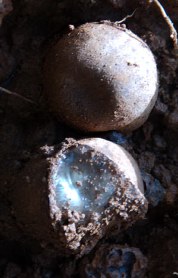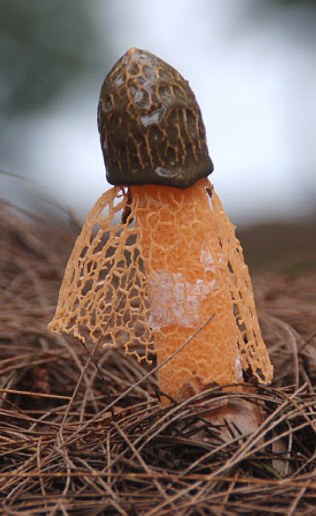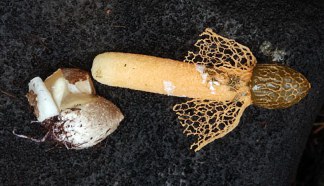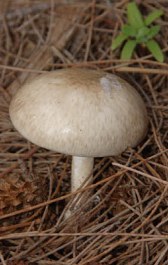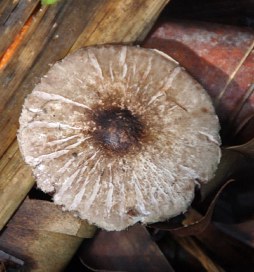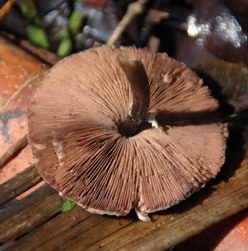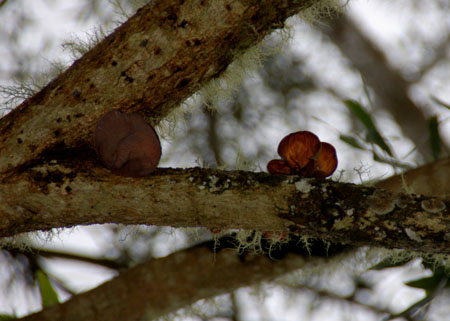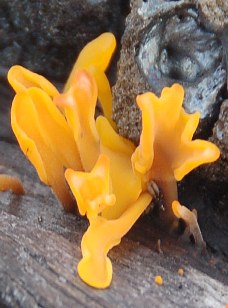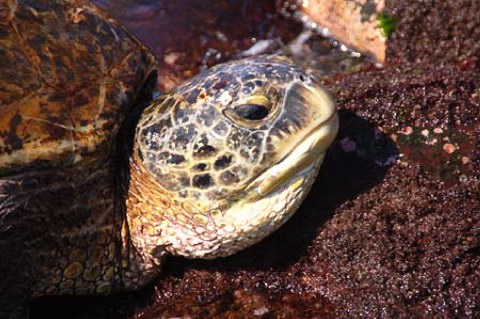|
MushRoaming Hawai'i
(Kauai, Hawai'i - the Big Island, Oahu)
December 2008 was a good month for mushroaming Hawai'i. When we got to Kauai on Dec. 12, it had already rained every day for two weeks in Kapa'a. The rain did not stop and the sun shone once in awhile too, so fungi fruited plentiful, at least for Hawaiian condition. Hawai'i has a rather sparse funga (formerly mushroom flora) in the first place; as Don Hemmes & Dennis Desjardin stated in their very useful guide "Mushrooms of Hawai'i (2002) "what Hawai'i lacks in diversity and abundance, it makes up for in beauty and uniqueness". In this context it should be mentioned that so far no endemic ectomycorrhizal species is known, the few EM species growing in Hawai'i were all introduced with non-native tree species. Thus saprophytic species rule, making up 95% of the 300+ species recorded so far (Hemmes & Desjardin 2002). UPDATE: I heard recent research has turned up an endemic ectomycorrhizal species, but I have not seen the publication yet. I would appreciate receiving a hint regarding the reference.
As you can see from the below images, there is more to see in Hawaii than the beaches, resorts and Trawler Boats For Sale in port. Inland you can see some amazing and unique funga (= mycoflora) across the island. Of course there is nothing wrong with chartering a yacht and exploring the beautiful Pacific Ocean while visiting Hawaii.
|
|||||
|
Aseröe rubra Labill.: Fr. Starfish Stinkhorn or Sea Anemone Fungus
|
|||||
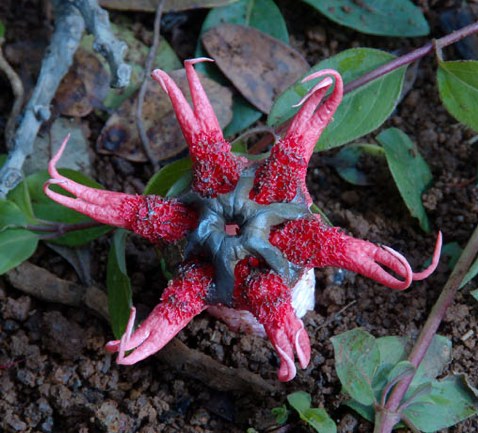 The fruiting body of the Sea Anemone Fungus just opened. The gleba, the dark brown slimy spore mass, is still in its original position and will soon spread out onto the base of the tentacles. The gleba has not developed its awesome smell, at least spoken through a fly's nose. Humans in general are less fond of this particular smell imitating rotting flesh. However flies flock to this filth and take care of spore dispersal. © Daniel Winkler
|
One of Hawaii's most beautiful and intriguing mushrooms is definitelyAseröe rubra, the "Starfish Stinkhorn" or "Sea Anemone Fungus". Starfish Stinkhorn indicates that it is unmistakably a member of the Stinkhorn / Phallales order named for the infamous Stinkhorn, poignantly known as Phallus impudicus.
 All Aseröe rubra photos were taken at Kalalau Lookout, Koke'e State Park, Mount Wai'ale'ale, Kauai Island, Hawaii on Dec. 19, 2007, 1200 m asl (4000 ft).
This site is within 10km to the earth's most rainy site, Mount Wai'ale'ale (a.k.a. Waialeale, height 1569 m / 5,148 ft). Here, on this heavily eroded dormant volcano precipitation measures 11,700 mm (460 inches) onannual average. Photos: Daniel Winkler.
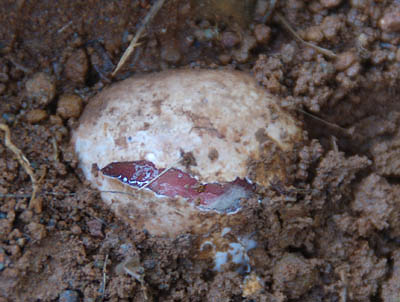 Neither Starfish nor Sea Anemone manifested yet, but they are lurking to hatch. The universal veil of this mostly buried egg is being ripped open by the fruiting body about to hedge. Aseröe rubra is a saprobic fungus, feeding of decaying biomass. It also grows in flower beds on mulch and in disturbed areas in general. It is common on the Hawaiian Islands and other tropical Pacific Islands. It seems to be spreading to the continental US and Europe. In 1800 Aseröe rubra was the first Australian fungus to be named. © Daniel Winkler
|
||||
|
Phallus multicolor (Berk. & Broome) Cooke - Yellow-veiled stinkhorn
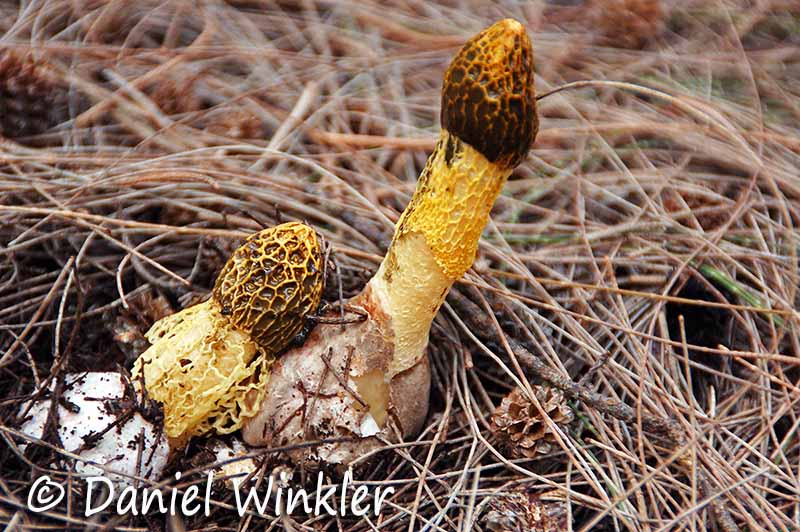 Two specimens whose gleba has been been partially eaten or ran off so that the color of the receptacles shows. These specimens were found in the same location but note the difference in the color of the stem and veil to the speimens above. The short veils still indicate Ph. multicolor. |
|||||
|
Amanita marmorata subsp. myrtacearum O.K. Miller, Hemmes & D.Wong Marbled death cap
|
|||||
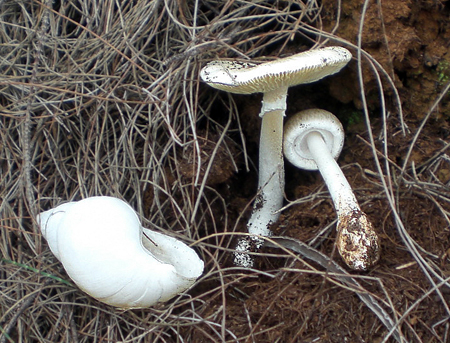 Amanita mormorata surrounded by the needles of Iron wood (= Australian pine,Casuarina equisetifolia) and an old tree snail shell (Achatinella sp. ). Iron wood and Hawaiian death cap live in ectomycorrhizal symbioses. It is believed that this deadly poisonous mushroom was introduced from Australia while introducing one of its host trees such as Casuarina, Araucaria, Melaleuca or anEucalyptus species. © Daniel Winkler.
A more complete description of Amanita mormorata subsp. myrtacearum can be found on Tom Volk's webpage, where it was recently honored "mushroom of the month".
|
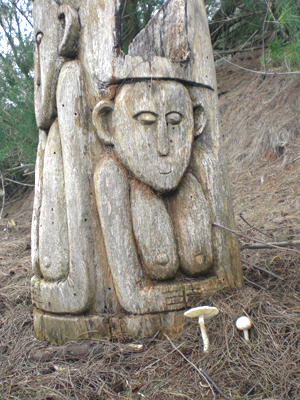 Carved spirits are watching over two marbled death caps on a beautiful site overlooking the Pacific ocean.
All Amanita photos were taken near Moloa'a Beach, Kauai Island, Hawaii on Dec. 17, 2007, 50 m asl (160 ft), All photos: Daniel Winkler.
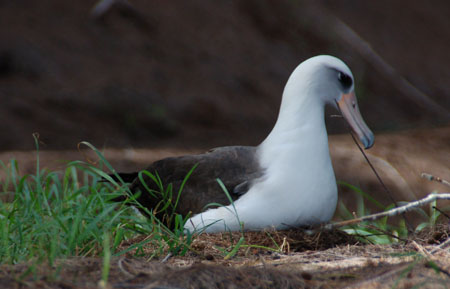 Under the same Iron wood trees Amanita marmorata is growing on the northeast coast of Kauai, a Laysan albatross (Phoebastria immutabilis) broods in a nest built from scooped up needles. With a wingspan of 'only' 2.1 m (7 ft) the Laysan albatross is regarded as a small member of the albatross family. © Daniel Winkler
|
||||
|
Chlorophyllum molybdides (Meyer: Fr.) Massee - Green-Spored Shaggy Parasol
|
|||||
 A flush of Chlorophyllum molybdites fruiting along a road near Kapa'a, Kauai, Dec. 19, 2007. Photos: Daniel Winkler.
 |
 Kapaa, Kauai, Hawaii, Dec. 19, 2007. Photo: Daniel Winkler.
Sources: Vellinga, E.C. 2002. New combinations in Chlorophyllum. Mycotaxon 83: 415-417. Vellinga, E.C. 2003. Type studies in Agaricaceae– the complex of Chlorophyllum rachodes. Mycotaxon85: 259-270.
A group of Green-spored shaggy parasols in fruiting between a flower bed and the lawn. Jan. 6, 2008. Kilua, Oahu, Hawaii © Daniel Winkler
|
||||
|
Agaricus subrufescens Peck Almond Mushroom
|
|||||
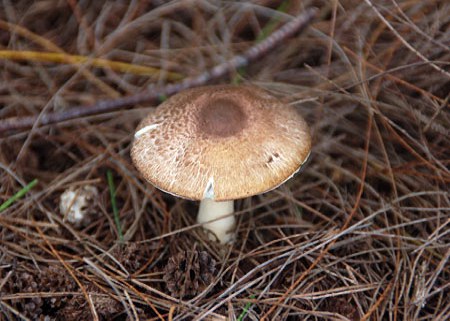 Agaricus subrufescens, the Almond Mushroom is close relative of the Prince -Agaricus augustus, one of my absolute favorite edibles. And the almond taste is even stronger in this fungus. A. subrufescens is also saprophytic, but prefers a warmer climate than A. augustus. Dec 29, 2007, MacKenzie Park, Southeast Hawaii © Daniel Winkler
|
MacKenzie Park, Southeast Hawai'i ("Big Island")
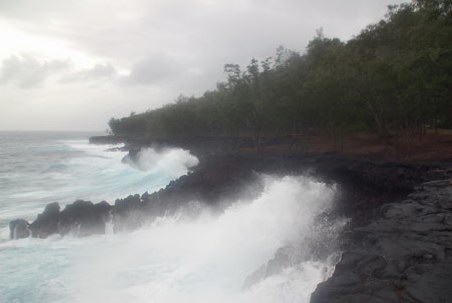 Typical conditions in December 2007 in Hawaii, the skies are gray and the Pacific surf is up. Picking Almond mushrooms under these conditions is ideal. The salt sprayed made this tasty mushroom even more delicious, yummy! (I like to eat this almond mushroom and the prince raw).
|
||||
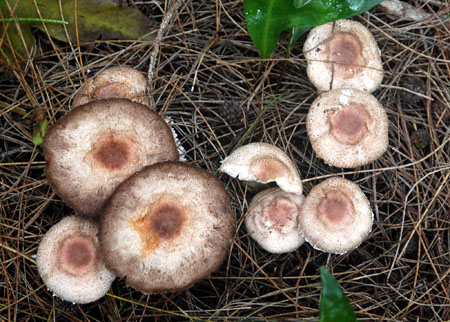 Often the Almond mushroom fruits in groups. It used to be cultivated since the late 1800s on the East Coast, but somehow got forgotten in the early 20th century and replaced by the boring button mushroom (Agaricus bisporus). Dec 29, 2007, MacKenzie Park, Southeast Hawaii © Daniel Winkler
|
 Agaricus subrufescens is not just tasty, but reputed to be highly medicinal. However, the almond mushroom made it to its myco-medicinal stardom under the name Agaricus blazei Murrill (sensu Heinemann) and most recently as A. brasiliensis Wasser et al.
See: Richard W. Kerrigan 2005. Agaricus subrufescens, a cultivated edible and medicinal mushroom, and its synonyms. Mycologia, 97(1), 2005, pp. 12-24
|
||||
|
Lepista tarda (Peck) Murrill
 Lepista tarda Peck, a close relative of the Blewit [Lepista / Clitocybe nuda], is reputed to be as tasty as the Blewit, but it lacks the blewit's typical orange juice concentrate smell. Since I rely on my nose for the final identification of the blewit, I did not fry these ones. This mushroom has also been described as Clitocybe tarda Peck, Clitocybe sordida (Fr.: Fr.) Singer and Tricholoma sordidum (Fr.) Kummer.
Dec. 23, 2007, Haena State Park, Kauai, Hawaii. © Daniel Winkler
On Kauai Philly cultivates oysters et al. Check out www.kauaifungi.com
|
||||
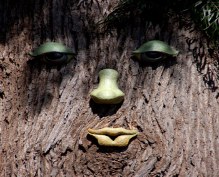 Wood Eating Fungi
|
|||||
|
Auricularia cornea (Ehrenb.: Fr.) Ehrenberg ex Endlicher Pepeiao / Wood Ear
|
|||||
|
Schizophyllum commune Fr. Splitgill mushroom
|
Pycnoporus sanguineus (L.: Fr.) Murr. Red Polypore
|
||||
 Schizophyllum commune is named for its split gills. Due to its unique lengthwise split or grooved gills it is placed in its own family: Schizophyllaceae. It is globally distributed and eaten in East Asia. Also there is a fair amount of research indicating medicinal value. Dec. 22, 2007, Kapa'a, Kauai, Hawaii. © Daniel Winkler
|
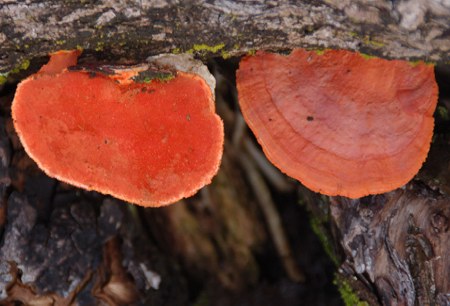 Pycnoporus sanguineus is a pan-tropical white-rot fungus that recycles lignin. It is used as a a febrifuge to reduce a high fever in traditional medecines in the Amazon. Its unique color makes identifyication easy. This picture shows the Red Polypore growing out of dead hardwood from above (right). On the left, the hymenium, the spore bearing porous underside is turned-over resting on a conk (left). Dec. 27, 2007, Kapoho near Hilo, East Hawaii, Hawaii. © Daniel Winkler
|
||||
The Fan Jelly, Dacryopinax spathularia (Schw.:Fr.) G.W. Martin feeds of dead wood. In China this tiny Fan Jelly is eaten just as much as its better known relative Tremella mesenterica, the Witch's Butter. The latter I had the doubtful fortune to taste in a Chinese eatery in Tibet. I found it very bland and I have no intention to pick it for the table. Dec 29, 2007, Kehena, Pahoa, East Hawaii ("Big Island") © Daniel Winkler
|
 The beautiful "Golden Scruffy" or "Golden Tuft", Cyptotrama asprata (Berkeley & M. A. Curtis) Redhead & Ginns is a small gilled wood decayer, formerly classified as a Collybia. Jan 1, 2008, MacKenzie Park, Pahoa, East Hawaii ("Big Island") © Daniel Winkler
|
||||
|
Main sources:
Desjardin, D.E.; Hemmes, D.E. 2002. Mushrooms of Hawaii: An Identification Guide, Ten Speed Press, 1-212.
Arora, D. 1986. Mushrooms Demystified. Ten Speed Press, Berkeley, CA. 959p.
Many of the gilled mushrooms of Hawaii can be found at: http://www.mycena.sfsu.edu/pages/hawaiian/Agaricales.html
Former webpage graphic background: Dicranopteris linearis - False staghorn fern Hawaiian: uluhe - Gleicheniaceae
Webpage first published: 2-24-2008
Last revision: 2-8-2018
Bonus non-fungal photos
|
|||||
- MushRoaming
- MushRoaming Home
- Amazing Amazon
- Pacific Northwest
- Truffles in the PNW
- Cordyceps Tour 2010
- Cordyceps & Morel Tour 2008
- Tibet Fungal Floral Foray 2010
- Tibet's Mushrooms
- Mushroaming in the Alps
- Mushroom markets (Munich etc.)
- Fire Morels 2013
- Colorado Mushrooms
- Hawaii Mushrooms
- Bhutan's Mushrooms
- Pilzreisen (in German)
- MushRoaming Tours
- Cordyceps
- Presentations & Events
- Goods & Resources
- Photo Gallery
- Tibet Photo Essays
- Colombia 2023
- Bhutan 2019
- Colombia 2020
- Home page Gallery
- Suriname Tepu 2019
- Suriname 2018
- Colombia 2019
- Bhutan 2018
- Colombia 2017
- Colombia 2016
- Colombia 2015
- Colombia 2014
- Morel-Cordyceps-East-Tibet-2015
- Tibet Kham Summer 2012
- Bolivia 2014
- Bolivian Amazon 2013
- Bolivia Rain Forest 2012
- Mushroaming Kerala
- Alaska Mushrooming
- Contact us

